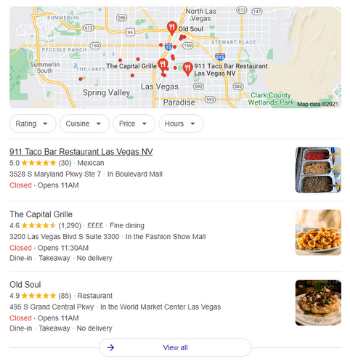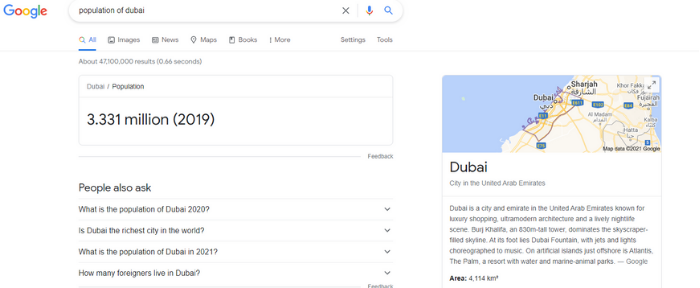
Are you missing out on traffic because people aren’t searching the way you think they are?
If your website isn’t optimized for voice search, then this could be the case. These six timely SEO strategies and resources for voice search will not only help you get more traffic from people using Siri and Alexa, but they will also become important pillars of your entire SEO strategy.
What Is Voice Search?
Voice search is a way of searching the internet through speech. Using artificial intelligence, a device can recognize your voice and put the query into a search engine.
Voice recognition has been around for a long time (since the early 1950s), but it wasn’t until 2011 when IBM’s Watson (you may remember it beating contestants on Jeopardy!) came out that it had practical real-world significance.
Today, voice search is everywhere. An eMarketer’s survey revealed that almost 40 percent of internet users in the U.S. use voice search, which highlights the ubiquitous nature of voice search-enabled devices.
Popular Voice Search Devices and Search Engines
If you look in your pocket or on your desk right now (perhaps even on your hand), there’s a good chance you’ll find a voice search device. One reason voice search is so popular is because the technology is in almost every device we use, making it super easy to access.
Here are some of the most popular voice search devices and the search engines they use:
- Google Home: Google
- Amazon Echo/Alexa: Bing
- Google Assistant: Google
- iPhone/Siri: Safari
- Android phones and devices: Google
- Microsoft Cortana: Bing
This means whether it’s your phone, TV, portable speaker, or any other device, it’s got the ability to search the internet through speech.
How Does Voice Search Affect SEO?
When you type a query into Google, what do you want it to do?
First, it’s got to understand what you mean by your query (helping it to understand the type of results you want to see), and then show you the best results that match your search query.
The way we type queries into Google is quite different from the way we talk to our voice assistants. For example, if you’re looking for a local restaurant to dine in, your searches might look a little like this:
- typed: “Restaurants near me”
- voice: “What are some good restaurants in my local area?”
When we type, we tend to use very keyword-based searches, but when we use voice search, our searches become much more conversational. This means search engines have had to become very good at semantics: understanding the meaning behind words.
The way we use language is complicated, and it’s not easy for machines to understand the meaning behind words (just think how many words have multiple meanings). Voice search has forced search engines to get much better at this though, and Google has led the way with key updates like Hummingbird.
This update and other previous ones have changed SEO, taking the focus away from keywords (in the early days, people would simply stuff keywords into their articles) and much more toward user experience.
Voice search has played a part in this shift, and it continues today, with a consistent focus on experience, rather than just keywords.
6 Ways to Optimize for Voice Search
Voice search is here to stay. Everywhere you look, there are voice search-enabled devices, and the percentage of voice searches as a share of total searches continues to grow (usage grew by eight percent between September 2018 and early 2019).
The good news is you don’t have to tear up your current SEO strategy to optimize for voice search. Voice search plays into the overall trend of matching user intent and providing the best possible user experience, so the tactics you use to optimize for voice search will benefit your SEO in general.
1. Optimize for Local Search
Many voice searches are for local information; they are three times more likely to be local searches than text-based ones.
If you think about it, this makes sense. When you’re out and about, and want a quick answer to your question, it’s easy to get out your mobile device and ask a question. This means it’s important you focus on the local element of your SEO.
For many businesses, local SEO is a fundamental part of digital marketing anyway. Local searches make up around 46 percent of total searches, and these are extremely engaged buyers. Local people are the people who will drop into your store and make a purchase there and then, and this means showing up in the local search pack is essential, especially if you’re a brick and mortar business.

Local SEO follows the same principles as regular SEO, and the key thing (that many websites neglect) is consistently telling people you’re a local business. Make sure you’re creating content that’s relevant to your local area and integrating local keywords into your copy.
Check out Ubersuggest to get local keyword ideas and make sure you’re answering the questions local people have:
- phrases people use to describe the neighborhood around your location
- “near me” in your title tags, meta description, internal links, and anchor text
- landmarks around your business location
- the titles of local institutions that are relevant to your business
Focusing on your local SEO will help your voice search, so check out my Definitive Guide to Local SEO.
2. Create Conversational but Concise Content
The days of stuffing your content with keywords simply to please crawlers are long gone. To be successful with SEO, you’ve got to be authentic, use language naturally, and offer valuable content.
Essentially, you have to be human (we all are, so this shouldn’t be a problem).
Voice search typifies this because when people search through speech, they tend to talk in a more natural way than they do when they’re typing a query into the search engines. Your content should match the conversational way people ask questions to their voice assistants, but not just for voice search reasons.
Today’s rankings are user experienced-focused. The pages that answer people’s questions in the best way while sharing the best experience, will rise to the top of the rankings.
To do this, you’ve got to give people quick access to the information they need (being concise) and do it in an enjoyable way (natural, conversational language). When you’re doing this, you’re not just matching the language people have used in their voice search (user intent), but you’re also driving engagement through your authentic brand voice.
3. Use Structured Data
Ask your voice-controlled device this question: “Who was the first President of the United States of America?”
What happens?
Chances are your device will start reading out an answer about George Washington.
This information is taken from a long page about George Washington though, so how does it know which bit of text to read? The answer probably lies in structured data.
Search engines look at a bunch of factors besides content to determine a page’s relevance and position in their search results. Professional SEOs leverage these additional factors to further optimize their content for search engines.
Schema markup, also known as structured data, is one such factor. It does not affect the rankings directly, but it can give you an edge over your competitors, particularly when it comes to voice search.
Essentially, it is metadata: data about the information on your site. It goes into your site’s source code. The visitors don’t see it, but microdata helps search engines to organize and classify your content. It is an underutilized strategy because it requires work.
Do you want an example?
The following markup classifies your contact details page as containing contact information.

Now, let me guess your next question: How is microdata relevant to voice search?
When users search for local businesses, they often look for operational hours, contact information, address, directions from highways, and the like.
You can use microdata to ensure that search engines classify this information.
Let’s search for the population of Dubai.

Google quickly retrieved the figure because of a markup.
Need another reason to work on your structured data?
A study found that over 40 percent of voice results were pulled from the featured snippet. Just like with voice search, featured snippets need to pull the exact information you’re looking for, so it’s likely they look at structured data to decide what information should be shown.
If you want a step-by-step guide on implementing schema markup, check out my guide to using Schema Markup.
4. Claim Your Google My Business Listing
Your Google My Business Listing is an essential part of local SEO and voice search.
Because voice searches are often used to find out important details about your business, such as contact number, address, and opening hours, Google must have accurate information on these details.
Your website and structured data go a long way in making sure Google has the right information about your business, but Google wants to be super accurate, and the way it does this is by looking at your Google My Business listing.
This will give Google all the information it needs to understand what your business does, who it’s for, when it opens, where it is, and much more. This is the exact information voice searches are asking for, so it’s a quick way to get accurate results to people’s questions.
5. Be Mobile Friendly
How are most voice searches made?
You want to show up in results through mobile devices, and you’ve got to offer a good mobile experience. This is a key part of Google’s algorithms, but there are still websites out there that aren’t optimized for mobile.
If this is the case with your website, people are going to click on your site and leave immediately because the page doesn’t work properly on their device. This is a big sign for Google that your page isn’t worthy of ranking, and it’s going to hurt you for both voice search and traditional queries.
I mentioned modern SEO is all about user experience and with the majority of traffic (and virtually all voice traffic) coming from mobile devices, this is something you have to be on top of.
There are lots of little things you can do to make your site more mobile-friendly, so make sure your website is offering the right experience for people who use voice search.
6. Create Content Answering Your Audience’s Frequently Asked Questions
People tend to use questions when making voice searches.
The great thing about this is Google gives you a great insight into the questions people are frequently asking.
Type a question that relates to your website, and take a look at the results. The chances are, you will see a box titled “people also ask.” The FAQ’s feature displays for many queries, and it shows you the questions your target audience is regularly asking.
With a clear picture of the questions people are using to search for information, you can start creating amazing content that answers those questions. As I’ve said throughout this article, it’s all about user experience, and the first thing you need if you’re going to give someone the right experience is valuable content.
Answer people’s questions, help solve their pain points and make it enjoyable. If you can do this better than all the other websites, then it’s going to give you an excellent chance of ranking.
Voice Search FAQ’s
Voice search SEO is the practice of optimizing your website to show up in search engine results pages for voice searches.
Voice search has had an impact on SEO. It’s all about understanding the meaning behind words, and this is a fundamental part of all SEO.
Devices with voice search capabilities are everywhere. This has led to huge growth in voice searches. If you’re not optimizing, you might be missing out on a big chunk of your audience.
Google has suggested 27 percent of mobile searches are voice searches.
Voice Search Conclusion
If you want to grow your organic traffic, then you should be aiming to rank well for voice searches. Not only are there a huge number of voice searches happening every day, but the techniques you use to optimize for these queries are a fundamental part of modern SEO.
Voice search has changed the way people search for information, and search engines have responded with updates to their algorithms. You need to respond as well, and by matching searcher intent and providing the right user experience, you can make sure you’re getting more organic traffic through voice search.
Are you optimizing for voice search yet?
from Blog – Neil Patel https://ift.tt/3enM9jZ

No comments:
Post a Comment